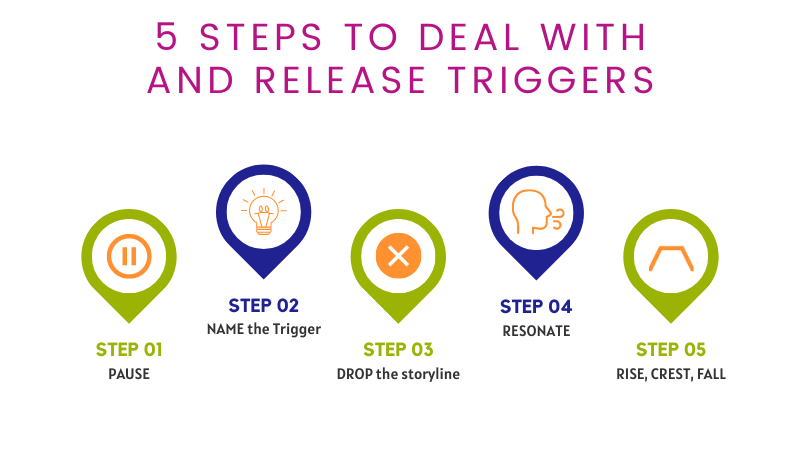
10 Jun 5 Steps to Deal With and Release Triggers
What’s a trigger?
You know…those moments when emotions and thoughts seem to unexpectedly erupt, creating mayhem in your inner world?
It's frustrating, isn't it?
We wish we had more control – if we're helping professionals, our clients definitely want a way out of reactivity so they can have more choice about how to respond to these triggers.
Well, over the years of working with people I’ve realized there are five powerful steps that can help people navigate and resolve triggers with more grace and peace.
1) PAUSE
The first step is to pause. Reflect on what happened just before the trigger. Was there an external event, a comment, a sound, or an image that preceded it? Explore deeper within yourself. What was happening internally? Sometimes external stimuli trigger something within us, but it could also be that an internal experience was bubbling up from the depths of our unconscious or subconscious.
2) NAME the trigger
Once you've identified the external factors, try writing them down. Note the time of day and what you were doing. This helps in naming the external triggers, which is often easier for most of us. Then, dive into naming the internal experiences. Slow down and track your moment-to-moment sensations. Take note of the thoughts, feelings, and body sensations that arise. Link them together, such as “When the doorbell rang, I tightened up…” In my books, “Becoming Safely Embodied” and “Attachment-Based Yoga & Meditation,” I guide you through deconstructing triggers and exploring the intricate web of thoughts, feelings, and sensations they evoke.
3) DROP the storyline
When triggers occur, we often build a storyline around them. The more we tell and retell that story, the more it solidifies and becomes deeply entrenched within us. Letting go becomes challenging as the story gains more realism and power with repetition. However, one of the most transformative practices is to drop the storyline altogether. Shift your focus to the essence of the experience. Notice the sensations beneath the thoughts and emotions, allowing them to exist without attaching additional narratives.
4) RESONATE
Having slowed down, paused, and named your experience, take another moment to pause. Breathe. Allow what has been happening to resonate within you. Is there something more waiting to emerge? Give yourself the space to connect with the deeper layers of your being.
5) RISE, CREST, FALL
Remember that everything in life follows a natural rhythm of rising, cresting, and falling. It's easy to overlook the subtle transitions when life moves swiftly, and equally overwhelming when everything feels amplified. However, as you embrace the previous steps—pausing, naming, dropping storylines, and resonating—you open the door for life to naturally rise, crest, and fall. By practicing presence and non-attachment, you create space for a more harmonious flow.
Incorporating these five steps into your life can bring about profound transformation, allowing you to find peace amidst chaos.

